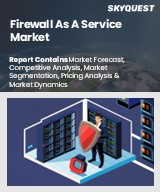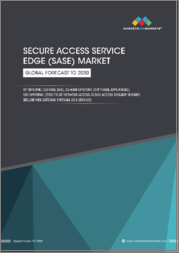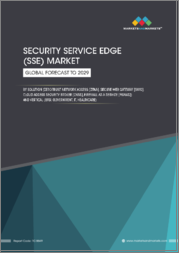
|
시장보고서
상품코드
1844400
FWaaS(Firewall-as-a-Service) 시장 : 유형, 딜리버리 모델, 도입 형태, 조직 규모, 최종 이용 산업별 - 세계 예측(2025-2032년)Firewall-as-a-Service Market by Type, Delivery Model, Deployment Mode, Organization Size, End User Industry - Global Forecast 2025-2032 |
||||||
FWaaS(Firewall-as-a-Service) 시장은 2032년까지 CAGR 15.21%로 58억 9,000만 달러로 성장할 것으로 예측됩니다.
| 주요 시장 통계 | |
|---|---|
| 기준 연도 2024년 | 18억 9,000만 달러 |
| 추정 연도 2025년 | 21억 8,000만 달러 |
| 예측 연도 2032 | 58억 9,000만 달러 |
| CAGR(%) | 15.21% |
FWaaS(Firewall-as-a-Service)에 대한 전략적 방향은 일관된 정책 실행, 운영 효율성, 확장 가능한 클라우드 네이티브 보안에 대한 경영진의 우선순위를 정의합니다.
Firewall-as-a-Service는 클라우드 전환, 원격근무, 복잡해지는 사이버 위협의 교차점에서 나아가는 기업에게 기반이 되는 기능입니다. 기업이 온프레미스 인프라에서 보안을 분리하는 가운데, FWaaS(Firewall-as-a-Service)은 일관된 정책 적용, 중앙 집중식 가시성, 간소화된 라이프사이클 관리의 길을 제시합니다. 이 소개에서는 서비스 기반 방화벽을 도입하는 전략적 근거를 설명하고, 통합 보안 프레임워크에서 방화벽의 역할을 설명하며, 경영 계획의 지침이 되는 우선순위를 구성합니다.
기업들은 어플라이언스 중심의 보안에서 워크로드 및 사용자 이동성에 따라 확장 가능한 클라우드 네이티브 컨트롤 포인트로 초점을 옮기고 있습니다. 이러한 변화의 배경에는 분산된 장치와 관련된 운영 오버헤드를 줄이고, 하이브리드 시설 전체에 걸쳐 위협 완화를 통합하며, 취약한 보안 사일로를 추가하지 않고도 새로운 서비스를 신속하게 배포할 수 있도록 지원해야 한다는 요구가 있습니다. 이에 따라 트래픽 필터링뿐만 아니라 ID 인식 제어, 자동화된 정책 오케스트레이션, 텔레메트리 기반 위협 탐지를 통합한 솔루션이 요구되고 있습니다.
경영진의 관점에서 방화벽-as-a-Service의 도입은 클라우드와 온프레미스 자산 간 일관된 보안 체계 확보, 분산된 환경 간 정책 적용 시간 최소화, 운영 효율화를 통한 총소유비용 절감, 중앙집중식 분석으로 인한 인시던트 대응 개선이라는 4가지 핵심 목표에 비추어 평가해야 합니다. 이러한 목표를 염두에 두고 기업은 규제 및 컴플라이언스 의무를 준수하면서 보다 광범위한 디지털 전환 목표에 부합하는 조달 및 아키텍처 선택을 구성할 수 있습니다.
클라우드 네이티브 아키텍처, ID 인식 제어, 자동화의 융합이 FWaaS(Firewall-as-a-Service) 제공 및 운영의 우선순위를 어떻게 바꾸고 있는가?
네트워크 및 애플리케이션 보호 환경은 아키텍처의 진화, 위협 요인의 고도화, 통합된 보안 경험에 대한 기업의 요구로 인해 크게 변화하고 있습니다. 이러한 변화는 클라우드 환경과 온프레미스 환경에서 방화벽을 구상하고, 제공하고, 이용하는 방식을 새롭게 바꾸고 있습니다. 기술 수준에서는 컨버전스가 가속화되고 있습니다. 방화벽 기능은 라우팅, 검사, 정책 관리를 단일 제어 플레인 아래 통합하는 보안 액세스 서비스 에지 구조 및 통합 보안 플랫폼에 점점 더 많이 통합되고 있습니다. 이러한 진화를 통해 분산된 워크로드 및 원격 사용자에 대한 일관된 적용이 가능해지고, 이기종 어플라이언스 관리 시 발생하는 마찰을 줄일 수 있습니다.
동시에, 아이덴티티 중심의 제어와 세분화된 애플리케이션 컨텍스트의 채택으로 방화벽의 역할은 거친 경계 필터링에서 사용자 아이덴티티, 디바이스 포지션, 애플리케이션 동작에 대응할 수 있는 정책 실행 포인트로 확대되고 있습니다. 이제는 자동화와 오케스트레이션이 필수적이며, 정책 템플릿, CI/CD 파이프라인 통합, 이벤트 기반 규칙 조정, 동적 클라우드 환경에 대응할 수 있는 정책 템플릿, CI/CD 파이프라인 통합, 이벤트 기반 규칙 조정이 가능해졌습니다. 머신러닝과 행동 분석은 또한 위협 탐지 및 이상 징후 점수화를 강화하여 보안 팀이 적의 활동적인 행동을 나타낼 가능성이 가장 높은 경보에 우선순위를 부여할 수 있도록 지원합니다.
이러한 패러다임의 변화는 운영 측면에도 영향을 미치고 있습니다. 보안팀은 서비스 계약, API 기반 정책 프레임워크, 텔레메트리 해석을 관리할 수 있는 기술을 발전시켜야 합니다. 조달 전략에서는 기능의 폭뿐만 아니라 기존 SIEM, SOAR, ID 시스템과 통합할 수 있는 공급자의 능력도 평가해야 합니다. 그 결과, 기업의 로드맵은 조직 차원의 거버넌스를 중앙 집중화할 수 있는 기능을 유지하면서 특정 위험 프로필에 맞게 구성할 수 있는 모듈식 상호 운용 가능한 솔루션을 점점 더 선호하고 있습니다.
2025년 관세 변화가 조달, 공급망 복원력, FWaaS(Firewall-as-a-Service) 도입 아키텍처 선택에 미치는 누적적 영향에 대한 아키텍처 이해
2025년 관세 및 무역 조치의 도입은 보안 기술 생태계에서 조달 경제성, 공급업체 공급망, 공급업체 선택 기준에 누적적인 영향을 미치고 있습니다. FWaaS(Firewall-as-a-Service)의 소프트웨어 중심 구성요소는 주로 무형적이지만, 하드웨어 종속성, 하이브리드 배포에 사용되는 특수 네트워크 어플라이언스, 보조 인프라 구성요소, 수입 관세 및 공급망 규제 변화에 민감합니다. 관세 인상으로 인해 하드웨어 및 특정 네트워크 구성요소의 조달 비용이 증가함에 따라, 기업들은 소프트웨어 우선의 클라우드 네이티브 구축과 조달 마찰이 발생할 수 있는 어플라이언스 중심 아키텍처 사이의 균형을 재평가하고 있습니다.
조달팀은 공급업체와의 관계를 다양화하고, 유연한 배송 모델을 가진 벤더를 우선시하며, 국경 간 하드웨어 배송을 최소화할 수 있는 옵션을 모색하는 등 다양한 대응책을 모색하고 있습니다. 벤더들 역시 관리형 옵션의 확대, 현지화된 인스턴스, 물리적 인프라에 대한 자본 지출의 필요성을 줄이는 구독 계층 등을 제공함으로써 상업적 모델을 조정하고 있습니다. 이러한 변화는 소비 기반 보안 서비스의 추세를 더욱 가속화하고, 가상 방화벽, DNS 기반 제어 및 하드웨어 설치 공간을 늘리지 않고도 인스턴스화할 수 있는 웹 애플리케이션 보호를 선호하는 아키텍처 선택을 강화할 것입니다.
또한, 규제 및 계약상의 고려사항이 더욱 두드러지게 나타나고 있습니다. 여러 관할권에 걸쳐 사업을 운영하는 조직은 보다 엄격한 벤더 리스크 평가를 실시하고, 부품 조달 및 컴플라이언스 증명에 대한 투명성을 요구하고 있습니다. 이러한 관행은 관세나 수출 규제로 인해 제조 및 물류가 중단되는 경우에도 공급망의 취약성을 완화하고 서비스의 연속성을 보장합니다. 결국, 관세의 누적된 영향으로 업계는 무역 정책의 변동에 노출되는 하드웨어에 대한 의존도를 줄이고, 보다 탄력적인 소프트웨어 정의 납품 패턴으로 향하고 있습니다.
FWaaS(Firewall-as-a-Service)에 대한 주요 세분화 기반 관점은 유형, 제공, 배포, 조직 규모, 산업별 요구사항에 따라 차별화된 행동을 보여줍니다.
FWaaS(Firewall-as-a-Service) 시장의 다양한 차원이 어떻게 서로 다른 아키텍처와 상업적 대응을 요구하는지를 보여주는 상세한 세분화 인사이트를 제공합니다. 유형별로는 클라우드 방화벽(가상 방화벽), DNS 방화벽, 네트워크 방화벽, 차세대 방화벽(NGFW), 웹 애플리케이션 방화벽(WAF)이 조사되었으며, 각각 고유한 원격 측정 풋프린트, 검사 요구사항, 통합 터치포인트가 있습니다. 검사 요구사항, 통합 터치포인트를 가지고 있습니다. 클라우드 방화벽과 NGFW는 동서 및 남북 흐름에 대한 광범위한 트래픽 검사 및 정책 오케스트레이션을 제공하는 반면, DNS 방화벽과 WAF는 각각 이름 확인 부정사용과 애플리케이션 계층 공격에 초점을 맞춘 전문적인 보호 기능을 제공합니다. 이러한 기능적 차이를 인식하는 것은 방어 계층을 구성하고 에스컬레이션 경로를 정의하는 데 매우 중요합니다.
목차
제1장 서문
제2장 조사 방법
제3장 주요 요약
제4장 시장 개요
제5장 시장 인사이트
제6장 미국 관세의 누적 영향 2025
제7장 AI의 누적 영향 2025
제8장 FWaaS(Firewall-as-a-Service) 시장 : 유형별
- 클라우드 방화벽(가상 방화벽)
- DNS 방화벽
- 네트워크 방화벽
- 차세대 방화벽(NGFW)
- 웹 애플리케이션 방화벽(WAF)
제9장 FWaaS(Firewall-as-a-Service) 시장 : 제공 모델별
- 통합 보안 플랫폼
- 독립형 FWaaS 프로바이더
제10장 FWaaS(Firewall-as-a-Service) 시장 : 전개 방식별
- 하이브리드 클라우드
- 프라이빗 클라우드
- 퍼블릭 클라우드
제11장 FWaaS(Firewall-as-a-Service) 시장 : 조직 규모별
- 대기업
- 중소기업
제12장 FWaaS(Firewall-as-a-Service) 시장 : 최종 이용 업계별
- BFSI
- 정부
- 헬스케어
- IT와 통신
- 소매
제13장 FWaaS(Firewall-as-a-Service) 시장 : 지역별
- 아메리카
- 북미
- 라틴아메리카
- 유럽, 중동 및 아프리카
- 유럽
- 중동
- 아프리카
- 아시아태평양
제14장 FWaaS(Firewall-as-a-Service) 시장 : 그룹별
- ASEAN
- GCC
- EU
- BRICS
- G7
- NATO
제15장 FWaaS(Firewall-as-a-Service) 시장 : 국가별
- 미국
- 캐나다
- 멕시코
- 브라질
- 영국
- 독일
- 프랑스
- 러시아
- 이탈리아
- 스페인
- 중국
- 인도
- 일본
- 호주
- 한국
제16장 경쟁 구도
- 시장 점유율 분석, 2024
- FPNV 포지셔닝 매트릭스, 2024
- 경쟁 분석
- Cisco Systems, Inc.
- Palo Alto Networks, Inc.
- Fortinet, Inc.
- Check Point Software Technologies Ltd.
- Zscaler, Inc.
- Juniper Networks, Inc.
- Forcepoint LLC
- Sophos Ltd.
- Barracuda Networks, Inc.
- Cloudflare, Inc.
The Firewall-as-a-Service Market is projected to grow by USD 5.89 billion at a CAGR of 15.21% by 2032.
| KEY MARKET STATISTICS | |
|---|---|
| Base Year [2024] | USD 1.89 billion |
| Estimated Year [2025] | USD 2.18 billion |
| Forecast Year [2032] | USD 5.89 billion |
| CAGR (%) | 15.21% |
A strategic orientation to Firewall-as-a-Service that defines executive priorities for consistent policy enforcement, operational efficiency, and scalable cloud-native security
Firewall-as-a-Service has become a cornerstone capability for organizations navigating the intersection of cloud migration, remote work, and increasingly complex cyber threats. As enterprises decouple security from on-premises infrastructure, service-delivered firewall capabilities provide a path to consistent policy enforcement, centralized visibility, and simplified lifecycle management. This introduction outlines the strategic rationale for adopting service-based firewalls, describes their role within converged security frameworks, and frames the priorities that should guide executive planning.
Enterprises are shifting focus from appliance-centric security to cloud-native control points that can scale with workloads and user mobility. This shift is driven by the need to reduce operational overhead associated with distributed device fleets, to unify threat mitigation across hybrid estates, and to support rapid deployment of new services without adding brittle security silos. The result is a demand for solutions that not only filter traffic, but also integrate identity-aware controls, automated policy orchestration, and telemetry-driven threat detection.
From an executive perspective, the decision to adopt Firewall-as-a-Service should be evaluated against four core objectives: ensuring consistent security posture across cloud and on-premises assets, minimizing time-to-policy across distributed environments, reducing total cost of ownership through operational efficiency, and improving incident response via centralized analytics. With these objectives in mind, organizations can structure procurement and architecture choices to align with broader digital transformation goals while preserving regulatory and compliance obligations.
How converging cloud-native architectures, identity-aware controls, and automation are reshaping Firewall-as-a-Service delivery and operational priorities
The landscape for network and application protection is undergoing transformative shifts driven by architectural evolution, threat actor sophistication, and enterprise demand for unified security experiences. These shifts are remapping how firewalls are conceived, delivered, and consumed across cloud and on-premises environments. At the technology level, convergence is accelerating: firewall capabilities are increasingly embedded within secure access service edge constructs and integrated security platforms that unify routing, inspection, and policy management under a single control plane. This evolution reduces the friction of managing disparate appliances while enabling consistent enforcement across distributed workloads and remote users.
Concurrently, the adoption of identity-centric controls and granular application context has elevated the role of the firewall from coarse perimeter filtering to a policy enforcement point that can act on user identity, device posture, and application behavior. Automation and orchestration are now essential, enabling policy templates, CI/CD pipeline integration, and event-driven rule adjustments to keep pace with dynamic cloud environments. Machine learning and behavioral analytics are also enhancing threat detection and anomaly scoring, allowing security teams to prioritize alerts that most likely represent active adversary behavior.
These paradigm shifts are producing operational implications as well: security teams must evolve skills to manage service contracts, API-driven policy frameworks, and telemetry interpretation. Procurement strategies must evaluate not only feature breadth but also the provider's ability to integrate with existing SIEM, SOAR, and identity systems. As a result, enterprise roadmaps increasingly favor modular, interoperable solutions that can be composed to meet specific risk profiles while retaining the ability to centralize governance at the organizational level.
Understanding the cumulative impact of 2025 tariff changes on procurement, supply-chain resilience, and architectural choices for Firewall-as-a-Service deployments
The introduction of tariffs and trade measures in 2025 has exerted a cumulative influence on procurement economics, vendor supply chains, and vendor selection criteria within the security technology ecosystem. While software-centric components of Firewall-as-a-Service remain primarily intangible, hardware dependencies, specialized network appliances used in hybrid deployments, and ancillary infrastructure components are sensitive to changes in import duties and supply-chain regulation. As tariffs raise the landed cost of hardware and certain networking components, organizations are reassessing the balance between software-first cloud-native deployments and appliance-anchored architectures that may carry higher procurement friction.
Procurement teams have responded by diversifying supplier relationships, prioritizing vendors with flexible delivery models, and seeking options that minimize cross-border hardware shipments. Vendors themselves are adjusting commercial models by offering expanded managed options, localized instances, and subscription tiers that reduce the need for capital expenditure on physical infrastructure. This shift further accelerates the trend toward consumption-based security services and reinforces architectural choices that favor virtual firewalls, DNS-based controls, and web application protections that can be instantiated without heavy hardware footprints.
Regulatory and contractual considerations have also become more prominent. Organizations operating across multiple jurisdictions are implementing more stringent vendor risk assessments and requiring transparency on component sourcing and compliance attestations. These practices mitigate supply-chain vulnerability and ensure continuity of service when tariffs or export controls disrupt manufacturing or logistics. Ultimately, the cumulative impact of tariffs has nudged the industry toward more resilient, software-defined delivery patterns that reduce dependence on hardware exposed to trade policy volatility.
Key segmentation-driven perspectives on Firewall-as-a-Service that clarify differentiated behaviors by type, delivery, deployment, organization size, and industry needs
Detailed segmentation insights reveal how different dimensions of the Firewall-as-a-Service market demand distinct architectural and commercial responses. Based on Type, the landscape is studied across Cloud Firewalls (Virtual Firewalls), DNS Firewalls, Network Firewalls, Next-Generation Firewalls (NGFW), and Web Application Firewalls (WAF), each with unique telemetry footprints, inspection requirements, and integration touchpoints. Cloud Firewalls and NGFWs offer broad traffic inspection and policy orchestration for east-west and north-south flows, whereas DNS Firewalls and WAFs provide specialized protections focused on name resolution abuse and application-layer attacks respectively. Recognizing these functional differences is critical when composing layered defenses and defining escalation paths.
Based on Delivery Model, the market is studied across Integrated Security Platforms and Standalone FWaaS Providers. Integrated platforms simplify operations by consolidating logging, policy management, and analytics, while standalone providers may offer deep specialization, rapid feature innovation, and flexible integration points. Choosing between integrated versus best-of-breed standalone approaches should be guided by existing vendor landscapes, desired consolidation levels, and tolerance for integration effort.
Based on Deployment Mode, the market is studied across Hybrid Cloud, Private Cloud, and Public Cloud. Each deployment mode imposes different connectivity, latency, and sovereignty constraints; hybrid cloud scenarios often require policy consistency across on-premises and cloud resources, private cloud environments emphasize control and compliance, and public cloud deployments prioritize elasticity and native service integration. Organizations must align deployment mode choice with application criticality and regulatory obligations.
Based on Organization Size, the market is studied across Large Enterprises and Small And Medium Enterprises. Large enterprises typically demand multi-tenancy support, advanced reporting, and complex policy hierarchies, whereas small and medium enterprises prioritize ease of use, rapid onboarding, and predictable pricing. Tailoring commercial models and implementation playbooks to organizational scale reduces friction and accelerates value realization.
Based on End User Industry, the market is studied across BFSI, Government, Healthcare, IT And Telecom, and Retail. Industry-specific threat models and compliance regimes shape feature prioritization; for example, BFSI and healthcare customers emphasize data protection and auditability, government entities focus on sovereignty and assurance, and retail organizations require robust DDoS and application security controls to protect e-commerce channels. Understanding industry context enables security teams to prioritize controls that address the most consequential risk vectors.
How regional regulatory landscapes, cloud maturity, and procurement customs shape differentiated Firewall-as-a-Service adoption across major global markets
Regional dynamics materially influence adoption patterns, regulatory constraints, and preferred delivery models for Firewall-as-a-Service. In the Americas, demand is often driven by rapid cloud adoption, high maturity in security operations, and a preference for integrated platforms that can streamline multi-cloud visibility. Commercial negotiations in this region typically emphasize service-level commitments, analytics richness, and ecosystem integrations that align with established tooling.
Europe, Middle East & Africa presents a more heterogeneous environment where data protection law, national security requirements, and local procurement practices shape buyer behavior. Sovereignty concerns and regulatory frameworks necessitate options for localized data processing, on-premises control planes, or regionally hosted instances. Vendors operating in this region need to demonstrate compliance capabilities and strong data governance to win enterprise and public-sector contracts.
Asia-Pacific exhibits a mix of advanced cloud-first adopters and markets with strong preferences for locally hosted solutions due to regulatory or performance considerations. Rapid digitalization in industries such as telecommunications and retail has produced high demand for scalable, API-driven firewalls, while certain public-sector buyers favor solutions that support localized deployment and vendor accountability. Across all regions, interoperability with local service providers and adaptability to regional regulatory shifts are decisive factors in vendor selection.
Critical corporate and product-level dynamics that distinguish Firewall-as-a-Service providers through integration strength, telemetry capability, and partnership ecosystems
Competitive dynamics within the Firewall-as-a-Service ecosystem center on product differentiation, strategic partnerships, and the ability to deliver measurable operational benefits. Leading providers focus on rich telemetry pipelines, seamless integration with identity and endpoint systems, and low-friction onboarding mechanisms that reduce time-to-value for customers. Strategic partnerships with cloud providers, managed service firms, and systems integrators extend market reach and provide customers with validated deployment patterns and support options.
Vendors differentiate through performance characteristics, inspection depth, and the fidelity of analytics used for prioritizing security incidents. Those emphasizing deep packet inspection and application-layer context often position themselves for environments with high threat exposure, while providers focusing on DNS and web application protections aim to deliver targeted defenses for specific attack vectors. Commercially, vendors are experimenting with consumption models that align cost to traffic volumes or policy complexity, enabling customers to better match spend with usage profiles.
Acquisition and alliance activity remains a mechanism for vendors to rapidly expand feature sets and address adjacent market needs. Organizations evaluating providers should consider product roadmaps, integration maturity, and support ecosystems to ensure that chosen solutions can evolve with changing architectural and threat landscapes. Ultimately, the most resilient vendor relationships are those that balance innovation velocity with predictable operational outcomes.
Actionable guidance for security and procurement leaders to align Firewall-as-a-Service adoption with architecture, supply-chain resilience, and operational transformation
Industry leaders can adopt targeted actions to derive strategic advantage from Firewall-as-a-Service adoption while mitigating operational and procurement risks. First, align firewall selection with an overarching security architecture and identity strategy to ensure policy portability and minimize policy divergence across environments. Investments in policy lifecycle tooling and automated testing will reduce configuration drift and improve change governance.
Second, prioritize vendors that demonstrate robust API ecosystems and pre-built integrations with identity providers, cloud-native controls, and analytics platforms. Such interoperability reduces integration risk and accelerates automation-driven operational models. Third, require transparency on component sourcing and service continuity provisions to manage supply-chain and tariff-related risks. Insist on contractual assurances that address data residency, patching cadence, and incident response SLAs.
Fourth, develop a phased adoption roadmap that begins with less critical workloads to validate policy frameworks and telemetry pipelines, and then expands to protect high-value assets. This staged approach enables security teams to mature detection and response playbooks in parallel. Finally, invest in workforce enablement to bridge the skills gap between traditional network firewall management and cloud-native security operations; cross-training network, cloud, and security engineering teams improves collaboration and reduces mean time to remediation.
A rigorous, practitioner-validated research methodology that integrates primary interviews, scenario analysis, and comparative evaluations for actionable insights
The research approach combined triangulated primary and secondary methods to ensure robustness and contextual relevance. Primary inputs included structured interviews with security architects, procurement leaders, managed service providers, and cloud platform engineers to capture first-hand operational experiences, procurement constraints, and required integration points. These qualitative engagements were complemented by anonymized case studies that illustrated deployment patterns, change-control practices, and incident response workflows.
Secondary analysis synthesized vendor documentation, technical whitepapers, regulatory texts, and publicly available operational guidance to validate feature capabilities, compliance claims, and architectural references. Comparative evaluation matrices were constructed to assess integration maturity, telemetry richness, and deployment flexibility. Scenario-based analysis was used to stress-test architecture choices across hybrid, private cloud, and public cloud environments, and to evaluate the operational implications of tariff-driven supply-chain constraints.
Throughout the methodology, emphasis was placed on reproducibility and practitioner relevance. Findings were validated through follow-up interviews and peer review by experienced security operations professionals to ensure that recommended practices are actionable and aligned with real-world constraints. This layered approach produced insights that bridge vendor capabilities with enterprise implementation realities.
Closing synthesis of strategic imperatives for adopting Firewall-as-a-Service that balances operational readiness, vendor selection, and resilient architecture
Firewall-as-a-Service represents a pivotal element in a modern security stack, combining scalable inspection, centralized policy control, and the operational benefits of service delivery. As organizations continue to pursue cloud-first strategies and distributed workforce models, adopting service-delivered firewall capabilities will be an essential enabler of consistent security posture and improved incident response. The interplay of architectural convergence, tariff-driven supply-chain pressures, and evolving threat techniques underscores the need for deliberate vendor selection and phased implementation approaches.
Executives should emphasize interoperability with identity systems, the availability of robust telemetry, and contractual assurances around service continuity when evaluating providers. Operational readiness-measured by policy governance, automation maturity, and cross-functional skillsets-will determine how effectively organizations translate vendor capabilities into reduced risk. By treating Firewall-as-a-Service procurement as a component of a holistic security transformation rather than a point-product decision, leaders can realize both defensive improvements and operational efficiencies.
The pathway forward requires a balance of pragmatic architecture choices, supplier risk management, and workforce investment. Organizations that adopt a staged rollout, prioritize integration and automation, and maintain transparency with providers about operational expectations will be best positioned to capture the strategic advantages of Firewall-as-a-Service while maintaining resilience against supply-chain and regulatory shocks.
Table of Contents
1. Preface
- 1.1. Objectives of the Study
- 1.2. Market Segmentation & Coverage
- 1.3. Years Considered for the Study
- 1.4. Currency & Pricing
- 1.5. Language
- 1.6. Stakeholders
2. Research Methodology
3. Executive Summary
4. Market Overview
5. Market Insights
- 5.1. AI-driven adaptive firewall policy engines enabling real-time threat detection and automated policy updates
- 5.2. Seamless integration of firewall-as-a-service solutions with secure access service edge architectures to streamline network security
- 5.3. Edge computing optimized firewall services providing low-latency security enforcement for distributed IoT networks
- 5.4. Automated encrypted traffic inspection capabilities addressing increasing SSL/TLS blind spots in cloud workloads
- 5.5. Consolidation of firewall-as-a-service with cloud-native microsegmentation for granular east-west traffic control
- 5.6. Regulatory compliance driven firewall-as-a-service deployments ensuring data sovereignty across multi-regional cloud environments
- 5.7. Integration of threat intelligence feeds with FaaS platforms to deliver predictive intrusion prevention and rapid incident response
- 5.8. Zero trust network access convergence with firewall-as-a-service to enforce continuous identity-based policy validation
- 5.9. Unified management consoles for cross-cloud firewall-as-a-service orchestration enhancing visibility and operational efficiency
- 5.10. Service-level agreement guarantees for throughput and uptime driving enterprise adoption of managed firewall-as-a-service offerings
6. Cumulative Impact of United States Tariffs 2025
7. Cumulative Impact of Artificial Intelligence 2025
8. Firewall-as-a-Service Market, by Type
- 8.1. Cloud Firewalls (Virtual Firewalls)
- 8.2. DNS Firewalls
- 8.3. Network Firewalls
- 8.4. Next-Generation Firewalls (NGFW)
- 8.5. Web Application Firewalls (WAF)
9. Firewall-as-a-Service Market, by Delivery Model
- 9.1. Integrated Security Platforms
- 9.2. Standalone FWaaS Providers
10. Firewall-as-a-Service Market, by Deployment Mode
- 10.1. Hybrid Cloud
- 10.2. Private Cloud
- 10.3. Public Cloud
11. Firewall-as-a-Service Market, by Organization Size
- 11.1. Large Enterprises
- 11.2. Small And Medium Enterprises
12. Firewall-as-a-Service Market, by End User Industry
- 12.1. BFSI
- 12.2. Government
- 12.3. Healthcare
- 12.4. IT And Telecom
- 12.5. Retail
13. Firewall-as-a-Service Market, by Region
- 13.1. Americas
- 13.1.1. North America
- 13.1.2. Latin America
- 13.2. Europe, Middle East & Africa
- 13.2.1. Europe
- 13.2.2. Middle East
- 13.2.3. Africa
- 13.3. Asia-Pacific
14. Firewall-as-a-Service Market, by Group
- 14.1. ASEAN
- 14.2. GCC
- 14.3. European Union
- 14.4. BRICS
- 14.5. G7
- 14.6. NATO
15. Firewall-as-a-Service Market, by Country
- 15.1. United States
- 15.2. Canada
- 15.3. Mexico
- 15.4. Brazil
- 15.5. United Kingdom
- 15.6. Germany
- 15.7. France
- 15.8. Russia
- 15.9. Italy
- 15.10. Spain
- 15.11. China
- 15.12. India
- 15.13. Japan
- 15.14. Australia
- 15.15. South Korea
16. Competitive Landscape
- 16.1. Market Share Analysis, 2024
- 16.2. FPNV Positioning Matrix, 2024
- 16.3. Competitive Analysis
- 16.3.1. Cisco Systems, Inc.
- 16.3.2. Palo Alto Networks, Inc.
- 16.3.3. Fortinet, Inc.
- 16.3.4. Check Point Software Technologies Ltd.
- 16.3.5. Zscaler, Inc.
- 16.3.6. Juniper Networks, Inc.
- 16.3.7. Forcepoint LLC
- 16.3.8. Sophos Ltd.
- 16.3.9. Barracuda Networks, Inc.
- 16.3.10. Cloudflare, Inc.



















